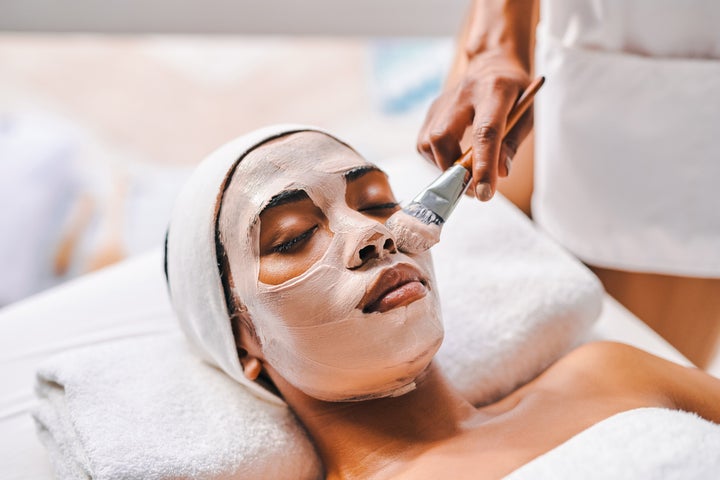Experts say the skin care routine for your boobs should require the same level of care as your face. Here’s what that should involve.
Skin care routines tend to focus on the face and neck, often involving a multi-step and multi-product regimen to address issues like UV exposure, dryness and signs of aging. But we typically stop at the neck, ignoring everything south of it. Is that a mistake?
Dermatologists say you should take the same level of care with the skin on other areas of the body, especially your breasts.
“It’s essential to recognize that breast skin is just as important as the skin on other parts of the body,” Annette LaCasse, a board-certified osteopathic physician and dermatologist in Commerce Township, Michigan, told HuffPost. “It’s sensitive and can be affected by factors like UV exposure, hormonal changes and aging.”
Besides the occasions when you show some cleavage, your breasts usually don’t get a lot of exposure to the elements. But that doesn’t mean they don’t need their own skin care routine, according to Dr. Ife Rodney, a board-certified dermatologist and founder of Eternal Dermatology and Aesthetics in Fulton, Maryland.
“The breast area is prone to exposure from tight clothing, friction and sun exposure, which could affect the skin’s integrity,” Rodney said. “It’s crucial to give the breast skin the attention it deserves to maintain its health and vitality.”
Establishing a skin care routine for your breasts also helps you keep an eye on them so you can detect any unusual changes in the skin or underlying tissue that might signal breast cancer, LaCasse said.
Here are a few things to know about your breast skin, why you should take special care of it, and what a skin care routine for your boobs should involve.
What you need to know about your breast skin
The skin is your body’s largest organ, and its depth can range from very thin, like the skin on your lips, to very thick, like the soles of your feet, explained Dr. Asfa Akhtar, a board-certified dermatologist at Cleveland Clinic Florida.
“Breast skin is delicate and thin,” she said. “Sebum production, which nourishes the skin with its own lipids, is lower in the skin of the breasts, as compared to the head and face.”
This makes the skin more susceptible to dryness, sunburns and age-related changes, Rodney said.
Breasts are also subject to hormonal fluctuations during puberty, menstruation, pregnancy and menopause, which can affect the skin’s texture and sensitivity and cause stretch marks, LaCasse said.
Aging might cause the skin on your breasts to lose elasticity and firmness, causing sagging and wrinkles, she added.
Why you need a breast skin care regimen
Devoting a skin care routine to your boobs that includes moisturizing and applying sunscreen can address issues like loss of collagen, discoloration, sun damage, dryness and sagging, Akhtar said. Cleavage and other areas of the breast that are exposed to the sun could be at risk for skin cancer and sunspots.
Regular moisturizing can also help minimize dry skin and reduce the appearance of stretch marks caused by pregnancy, breastfeeding and weight fluctuations, LaCasse said.
A breast-centric skin care routine will also help address issues like chafing or yeast infections that can happen underneath the breasts, said Dr. Carmen Castilla, a board-certified dermatologist in New York City and clinical instructor at Mount Sinai Hospital.
These problems can be remedied by using anti-chafing ointment and powders to keep the area under the breasts dry, and by wearing bras that fit well, she said.
Finally, caring for the skin of your breasts can help ensure you’re keeping up with your regular breast self-exams and will help you notice changes that could be early warning signs of breast cancer, LaCasse said.
You should talk to your doctor if you notice irritation or dimpling on your breast skin, redness or flakiness around the nipples, pain, rashes, lumps or any change in the size or shape of your breasts, according to the Centers for Disease Control and Prevention.

What a breast skin care routine should include
A breast-centric skin care routine should resemble what you already do for your face. Rodney said to start by cleansing with a mild, pH-balanced cleanser to remove dirt and sweat.
Then moisturize, using a hypoallergenic and fragrance-free product. LaCasse suggested looking for moisturizers with ingredients like hyaluronic acid or glycerin.
Try a firming serum or cream, Rodney said. Just look for products with hyaluronic acid, peptides and antioxidants that promote firmness and elasticity.
Apply sunscreen with an SPF of 30 or higher to the breast area, especially when you’re going to be outside for long periods, Akhtar said. “Tanning and sunburns should be avoided, as they can lead to damage of the skin and increase the risk of skin cancer.”
Avoid harsh chemicals, abrasive exfoliants and chemical peels that can damage the gentle breast skin, Akhtar said. If you’re trying to get pregnant, or you’re already pregnant or breastfeeding, you should avoid using retinol products, she added.
More and more skin care products designed specifically for the breasts have emerged, but dermatologists suggest using them with caution, as results may vary from person to person. Here are some they recommend:
- SkinCeuticals Body Tightening Concentrate. It contains peptides and proteins to help firm the skin.
- True Botanicals Neck, Décolleté & Boob Cream. It’s rich in moisturizing ingredients, like ceramides, jojoba oil and fatty acids.
- Mio Boob Tube Bust Tightening Cream. It contains hyaluronic acid and niacinamide for hydrating and firming.
- Carpe Sweat Absorbing Breast Lotion. It can help prevent under-boob sweating and chafing, which can lead to skin irritation and even yeast infections.
- Belly Bandit Don’t Sweat It Bra Liners. These inserts can be used under your bra to help absorb sweat.
- Vaseline All-Over Body Balm Stick. This can be used to help prevent chafing.
Credit: Source link